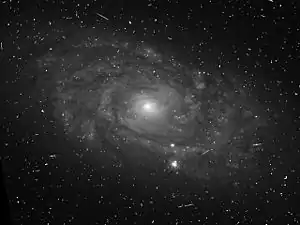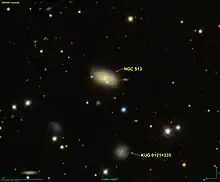| NGC 513 | |
|---|---|
 NGC 513 (NASA/ESA HST) | |
| Observation data (J2000[1] epoch) | |
| Constellation | Andromeda[2] |
| Right ascension | 01h 24m 26.8s[3] |
| Declination | +33° 47′ 58″[3] |
| Redshift | 0.019560 ± 0.000357[1] |
| Heliocentric radial velocity | (5807 ± 107) km/s[1] |
| Distance | 262 Mly[4] |
| Apparent magnitude (V) | 12.9[2] |
| Apparent magnitude (B) | 13.6[2] |
| Characteristics | |
| Type | Sc[2] |
| Apparent size (V) | 0.9' × 0.6'[2] |
| Other designations | |
| PGC 5174, UGC 953, GC 297, MCG +06-04-016, 2MASS J01242680+3347585, IRAS F01216+3332[1][5] | |
NGC 513, also occasionally referred to as PGC 5174 or UGC 953, is a spiral galaxy in the constellation Andromeda.[2] It is located approximately 262 million light-years from the Solar System[4] and was discovered on 13 September 1784 by astronomer William Herschel.[5]
Observation history

Herschel discovered the object and simply noted "stellar". Therefore, the galaxy was probably mistaken for a star. Herschel discovered this galaxy along with many other objects on a single observation, using Beta Andromedae as a reference star. The position noted is correct and off only by approximately 30" from UGC 953, thus the objects are generally viewed as equivalents.[6] John Louis Emil Dreyer, creator of the New General Catalogue, described the galaxy as "faint, small, stellar", still indicating the misidentification of NGC 513 as a star.[5]
One supernova has been observed in NGC 513: SN 2023jpp (type Ia, mag. 17.6).[7]
Description
The galaxy has an apparent size of 0.9 × 0.6 arcmins and a recessional velocity of approximately 5807 kilometers per second. The redshift of 0.01956 allows an estimate of the galaxy's distance using Hubble's law, which puts the object at roughly 260 million light-years from the Sun.[5]
See also
References
- 1 2 3 4 "NGC 513". Retrieved 2017-12-09.
- 1 2 3 4 5 6 "Revised NGC Data for NGC 513". spider.seds.org. Retrieved 2017-10-05.
- 1 2 "Your NED Search Results". ned.ipac.caltech.edu. Retrieved 2017-10-05.
- 1 2 An object's distance from Earth can be determined using Hubble's law: v=Ho is Hubble's constant (70±5 (km/s)/Mpc). The relative uncertainty Δd/d divided by the distance is equal to the sum of the relative uncertainties of the velocity and v=Ho
- 1 2 3 4 "New General Catalog Objects: NGC 500 - 549". cseligman.com. Retrieved 2017-10-16.
- ↑ "astronomy-mall.com/Adventures.In.Deep.Space/NGC%201-7840%20complete.htm".
- ↑ Transient Name Server entry for SN 2023jpp. Retrieved 13 June 2023.
External links
- NGC 513 on WikiSky: DSS2, SDSS, GALEX, IRAS, Hydrogen α, X-Ray, Astrophoto, Sky Map, Articles and images
- SEDS